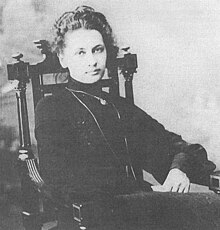Yekaterina Pavlovna Peshkova, née Volzhina (Russian: Екатери́на Па́вловна Пешко́ва, née Во́лжина; 26 July 1876 – 26 March 1965) was a Soviet human rights activist and humanitarian, first wife of Maxim Gorky.
Yekaterina Peshkova | |
|---|---|
 | |
| Born | July 26, 1876 |
| Died | March 26, 1965 (aged 88) Moscow, Soviet Union |
Biography
editShe was born on July 14 (26), 1876, into a noble family in the city of Sumy. There are three known versions of her birth date. She graduated from high school in Samara in 1895. In 1895, she worked as a proofreader at the Samara Newspaper, where she met Alexey Peshkov (Gorky), who was published in the publication.[1]
On August 30, 1896, Peshkov and Yekaterina got married. In 1897, Yekaterina gave birth to a son, Maxim, and in 1901, a daughter, Katya. In 1902-1903, the family lived in Nizhny Novgorod (now the A. M. Gorky Museum-Apartment). She repeatedly visited and lived in Yalta, working at the Yalta Alexandrovskaya Gymnasium. The couple separated by mutual consent. Five-year-old daughter Katya died of meningitis in the summer of 1906, when Gorky and Maria Andreyeva were in the United States, from where Alexei Maksimovich sent his abandoned wife in Nizhny a consoling letter with a request to take care of their remaining son.[2][3] However, they "maintained a special relationship throughout their lives," noted their granddaughter Marfa.[4] According to published data, the divorce was never officially formalized, which partly explains the fact that Gorky never entered into another registered marriage.[1]
In 1907-1914, she lived abroad with her son Maxim, mainly in Paris. She attended French courses for Russians at the Sorbonne and lectures on social sciences. She worked in the Circle for Assistance to Penal Servitude and Exile, organized by V. N. Figner.
Before the October Revolution she took an active part in the work of the Committee for Assistance to Russian Political Prisoners (Комитет помощи русским политкаторжанам) under the leadership of Vera Figner. After 1914 she led the Children's Commission at the Society for Assistance to War Victims. After 1918 she was the major activist of the Moscow Committee of the Political Red Cross.
After 1922, she was chairwoman of the subsequent organization the Assistance to Political Prisoners (Pompolit, Помощь политическим заключенным, Помполит). She was honored by an order of the Polish Red Cross for her participation in the exchange of prisoners of war after the Polish–Soviet War.
In 1927, she was instrumental in securing the commutation and release of Yosef Yitzchak Schneersohn after he was accused of counter-revolutionary activities, and sentenced to death.[5][6][7]
References
edit- ^ a b "Три жены Максима Горького". Archived from the original on 2014-01-30. Retrieved 2014-01-31.
- ^ Павел Басинский (2005). Горький. М.: Молодая гвардия. ISBN 5-235-02850-3.
- ^ Дмитрий Быков (2012). Был ли Горький? (2000 экз ed.). М.: АСТ. Астрель. ISBN 978-5-17-054542-1.
- ^ "Марфа-красавица - Новости общества и общественной жизни - МК". Archived from the original on 2013-04-05. Retrieved 2013-03-23.
- ^ Rubin, Mordechai. "13 Powerful Pictures That Illuminate the Arrest and Liberation of the Sixth Lubavitcher Rebbe". Chabad.org. Retrieved July 11, 2022.
- ^ "Rabbi Yosef Yitzchak Schneersohn". www.jewishvirtuallibrary.org. Retrieved 2022-07-12.
- ^ Miller, Chaim (2014). Turning Judaism Outward. Kol Menachem. p. 53. ISBN 9781934152362.
External links
edit- (in Russian) Yaroslav Leontiev Dear Yekaterina Pavlovna
- (in Russian) History of Political Red Cross
- The Murder of Maxim Gorky. A Secret Execution by Arkady Vaksberg. (Enigma Books: New York, 2007. ISBN 978-1-929631-62-9.)